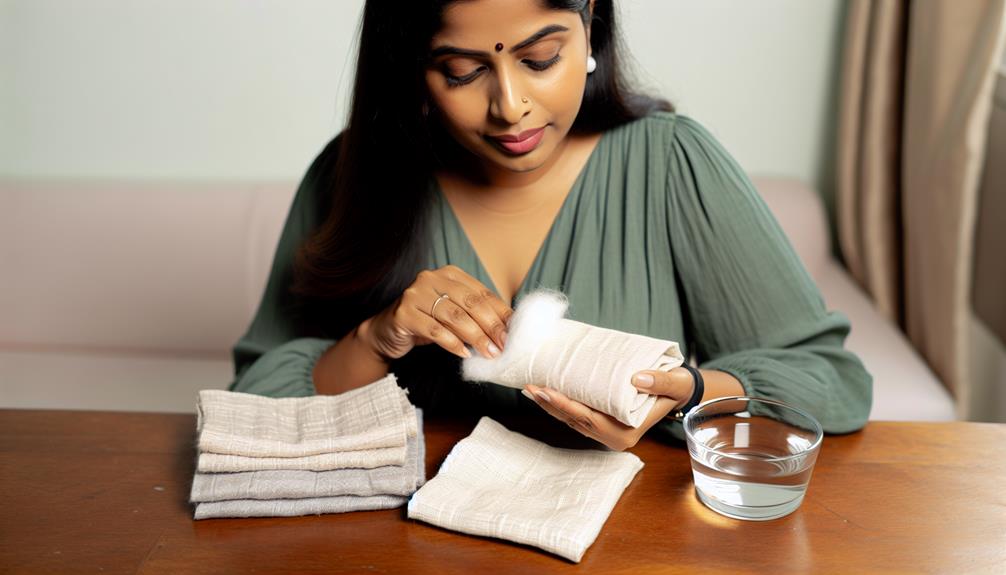Blog
Selecting Fluff-Free Tea Towels
When it comes to choosing fluff-free tea towels, we all seek materials that can withstand the rigors of daily kitchen use without leaving a trail of lint behind. By focusing on specific fabric types and weave patterns, we can guarantee our towels remain efficient and presentable. But have you ever considered how the color or design of a tea towel can impact its performance? Join us as we explore this often overlooked aspect of selecting the perfect tea towel to elevate your kitchen experience.
Factors to Consider
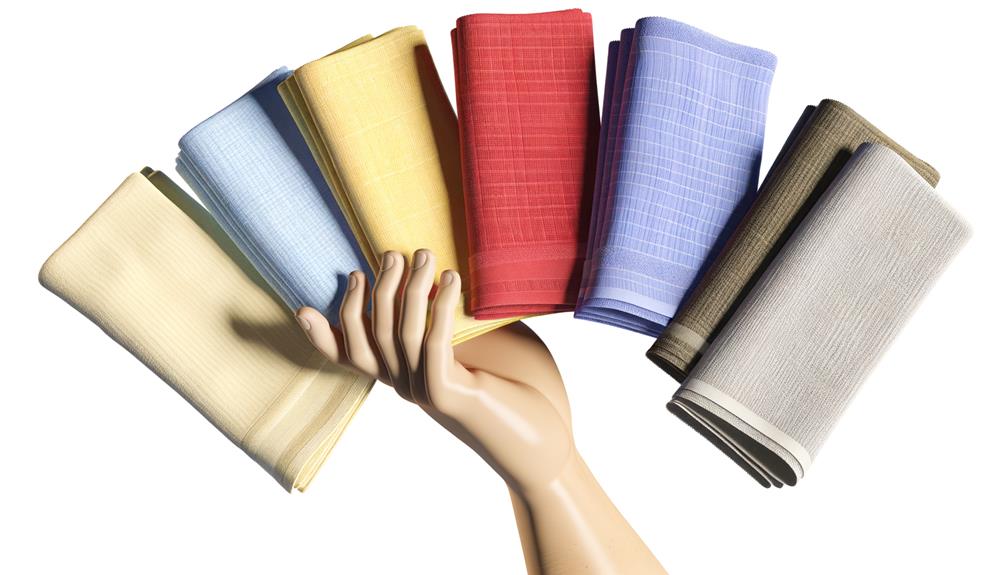
When selecting tea towels, we prioritize quality over aesthetics to guarantee durability and functionality. Our focus is on finding tea towels that can withstand frequent use and multiple washes without losing their absorbency or shape. It's important to take into account the weight of the tea towel, as heavier towels tend to be more durable and absorbent. Look for tightly woven fabrics that are known for their strength and longevity.
Another factor to take into consideration is the size of the tea towel. A larger towel provides more surface area for drying dishes or hands, while a smaller towel may be more convenient for everyday tasks. Think about how you plan to use the towels and choose sizes that best fit your needs.
Additionally, pay attention to the edges of the tea towel. Look for towels with hemmed edges or double-stitched seams to prevent fraying and ensure long-lasting quality. By taking these factors into account, you can select tea towels that aren't only functional but also durable for everyday use.
Material Matters
Why is the choice of material essential when selecting tea towels for your kitchen?
The material of a tea towel greatly impacts its absorbency, durability, and overall performance.
Cotton is a popular choice for tea towels due to its excellent absorbent qualities, making it ideal for drying dishes and hands. It's also soft and gentle on surfaces, preventing scratches or damage.
Linen tea towels are highly absorbent as well, but they tend to be more lightweight and quick-drying compared to cotton.
Microfiber tea towels are another option known for their super absorbency and ability to pick up dirt and grease effectively. They're also quick-drying and lint-free.
Bamboo tea towels are eco-friendly and naturally antibacterial, making them a hygienic choice for kitchen use.
Understanding the different materials available will help you select tea towels that suit your specific needs and preferences in the kitchen.
Weave Type Guide
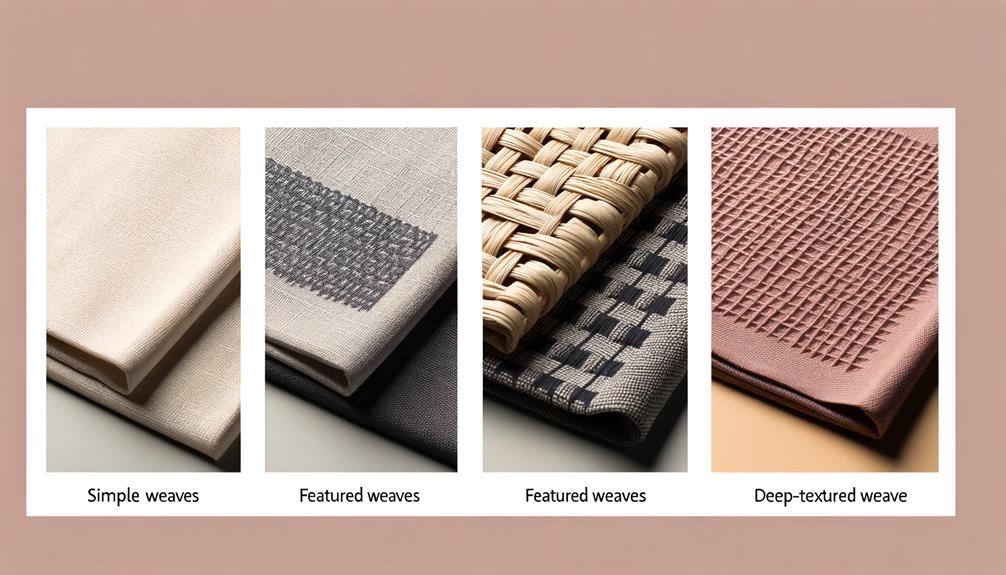
Exploring the various weave types of tea towels provides insight into their unique characteristics and functionalities. When it comes to tea towel weaves, there are a few common types worth evaluating. The most popular weave types include plain weaves, twill weaves, and herringbone weaves.
Plain weaves are simple and tight, making them durable and great for everyday use. They offer a smooth surface that's perfect for tasks like drying dishes or wiping countertops.
Twill weaves have a diagonal pattern that adds a bit of texture to the towel. This weave type is known for its strength and absorbency, making it ideal for heavy-duty kitchen tasks.
Herringbone weaves are structured with a distinctive V-shaped pattern that provides excellent scrubbing power. These towels are great for tackling tough messes and spills.
Each weave type offers unique benefits, so assess your specific needs when selecting the perfect tea towel for your kitchen.
Absorbency Levels
Understanding the absorbency levels of tea towels is essential for selecting the most suitable option for your kitchen tasks. The absorbency of a tea towel is determined by its material and construction. Cotton tea towels are known for their high absorbency, making them ideal for drying dishes and wiping up spills. Look for tea towels labeled as 'highly absorbent' or made from a tight-weave cotton fabric for the best performance.
When comparing absorbency levels, consider the thickness of the tea towel. Thicker towels often have greater absorbency capacity, while thinner towels may dry quickly but hold less moisture. Additionally, microfiber tea towels are popular for their super-absorbent properties, making them efficient for cleaning and drying tasks in the kitchen.
To test the absorbency of a tea towel, simply wet it under the faucet and observe how quickly and effectively it soaks up the water. A highly absorbent tea towel will leave surfaces dry with minimal effort, making kitchen chores easier and more efficient.
Fluff-Free Testing
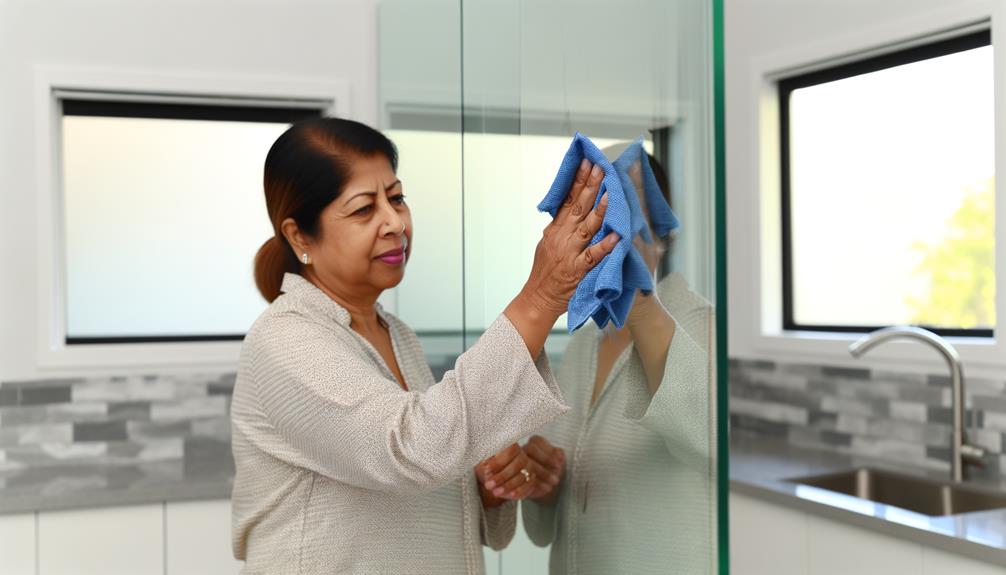
For a reliable assessment of a tea towel's absorbency, conducting a fluff-free testing method is crucial. To guarantee that the tea towel is truly absorbent and doesn't leave behind any unwanted residue, we recommend a simple yet effective test. Begin by wetting the tea towel thoroughly and then drying a glass surface with it. If the tea towel leaves no fluff or lint behind on the glass, it passes the fluff-free test. This method allows you to gauge the towel's absorbency without worrying about any residual fluff sticking to surfaces.
When conducting the fluff-free test, pay close attention to the texture of the tea towel. A smooth texture is usually indicative of a lower likelihood of leaving fluff behind. Additionally, consider the material of the tea towel, as certain fabrics are more prone to shedding than others. By performing this straightforward test, you can confidently select tea towels that offer excellent absorbency without the hassle of fluff residue.
Size Selection Tips
When choosing tea towels, consider selecting sizes that best suit your needs for peak functionality. The size of a tea towel can greatly impact its usability in the kitchen. If you often find yourself working with large pots and pans, opting for larger tea towels can provide better coverage and protection from spills. On the other hand, smaller tea towels may be more convenient for everyday tasks like drying dishes or wiping down countertops.
It's crucial to assess your typical kitchen activities to determine the most suitable size for your tea towels. For baking enthusiasts, larger tea towels can serve as handy surfaces for rolling out dough or covering rising bread. Smaller tea towels are perfect for tasks that require precision, such as wrapping around delicate glassware.
Ultimately, the size of your tea towels should align with how you intend to use them in your kitchen. By selecting sizes that cater to your specific needs, you can guarantee maximum practicality and efficiency in your daily culinary endeavors.
Color & Design Options
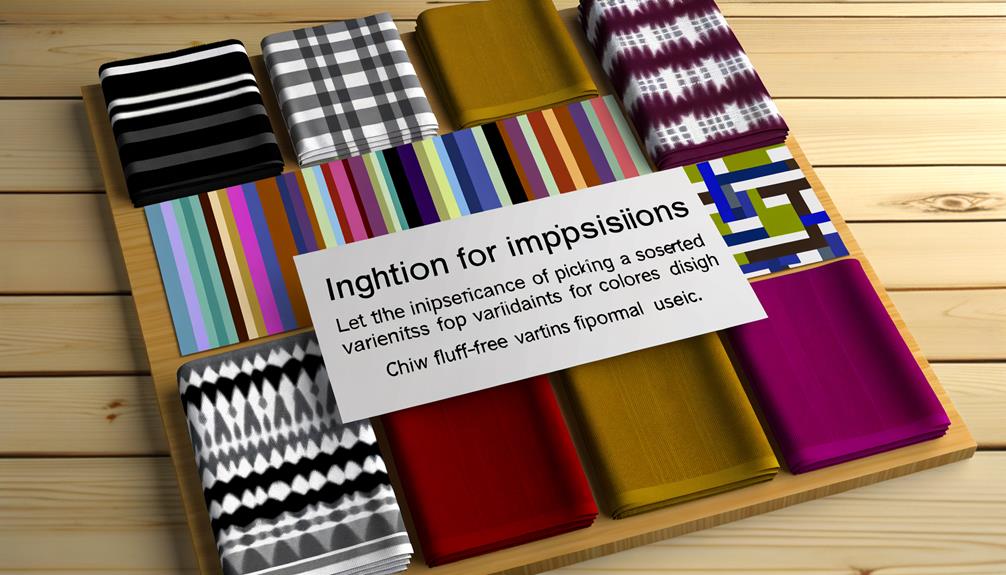
Considering the size of tea towels that best suit our needs, we can now explore the various color and design options available to enhance our kitchen aesthetics and functionality. When it comes to color choices, we can opt for classic whites and neutrals for a clean and timeless look that matches any kitchen decor. Alternatively, bright and bold colors can add a pop of fun and personality to the space. Patterns such as stripes, checks, or floral designs can also bring visual interest to the kitchen while hiding potential stains or marks.
For those looking to mix and match, coordinating sets with complementary colors or designs can create a cohesive and stylish look. Additionally, reversible tea towels offer versatility with different designs on each side. Consider the material of the tea towel when choosing colors and designs, as certain fabrics may hold dyes better or offer different textures that impact the overall appearance. Ultimately, selecting colors and designs that resonate with our personal style and kitchen decor won't only elevate the space aesthetically but also make the daily use of tea towels a more enjoyable experience.
Care & Maintenance Advice
How can we guarantee our tea towels remain in top condition for long-lasting use? Proper care and maintenance are vital to extending the lifespan of your tea towels. To keep them looking fresh and performing well, it's crucial to follow a few simple guidelines.
Start by washing your tea towels in warm water with mild detergent to remove stains and dirt effectively. Avoid using bleach as it can weaken the fabric fibers over time. Additionally, opt for air-drying or tumble drying on low heat to prevent shrinkage and maintain the towel's integrity.
Regularly inspect your tea towels for any signs of wear and tear, such as fraying edges or loose threads. Trim any loose threads to prevent further damage and maintain the towel's appearance. If your tea towels have decorative elements like embroidery or prints, consider washing them inside out to preserve the design.
Eco-Friendly Options
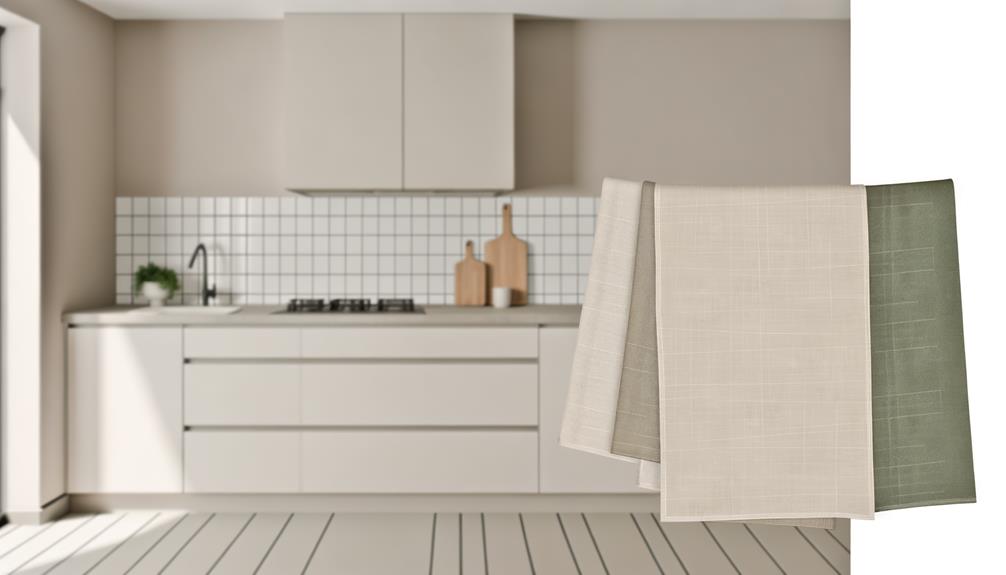
To make a more environmentally conscious choice when selecting tea towels, exploring eco-friendly options can be beneficial for both sustainability and quality. When looking for eco-friendly tea towels, consider materials like organic cotton, bamboo, or linen. These materials are biodegradable, renewable, and often produced using sustainable practices. Organic cotton is grown without harmful chemicals, making it a safe and eco-conscious choice. Bamboo is a fast-growing plant that requires minimal water and no pesticides, making it a sustainable option. Linen is durable, absorbent, and naturally antimicrobial, reducing the need for frequent washes and extending the towel's lifespan.
Additionally, look for tea towels that are certified by organizations like Global Organic Textile Standard (GOTS) or OEKO-TEX to make certain they meet specific environmental and social criteria. These certifications guarantee that the tea towels are produced using eco-friendly processes and materials. By opting for eco-friendly tea towels, you can reduce your environmental impact while enjoying high-quality, sustainable products in your kitchen.
Budget-Friendly Picks
Exploring cost-effective options for tea towels can help you find budget-friendly picks without compromising on quality. When on a budget, it's crucial to search for tea towels that offer good value without sacrificing durability. One excellent choice is the XYZ Basic Cotton Tea Towels. These towels are made from 100% cotton, providing excellent absorbency and softness at an affordable price point. They come in a pack of six, offering great value for money.
Another budget-friendly option to take into account is the ABC Microfiber Kitchen Towels. These towels are known for their quick-drying properties and excellent cleaning capabilities. Despite being gentle on delicate surfaces, they're sturdy enough to handle everyday kitchen tasks. The pack includes eight towels, making it a cost-effective choice for those looking to stock up on kitchen essentials without breaking the bank.
Conclusion
In choosing fluff-free tea towels, remember to prioritize materials that shed less, like microfiber or tightly woven cotton. Conduct a simple test to make sure the towel leaves no lint behind.
Opt for smooth textures and sturdy weaves for long-lasting absorbency. With a wide range of colors and designs available, caring for your tea towels properly will keep them looking fresh.
Make an eco-friendly and budget-friendly choice that will stand the test of time. Choose wisely, and let your kitchen shine like a polished gem.

